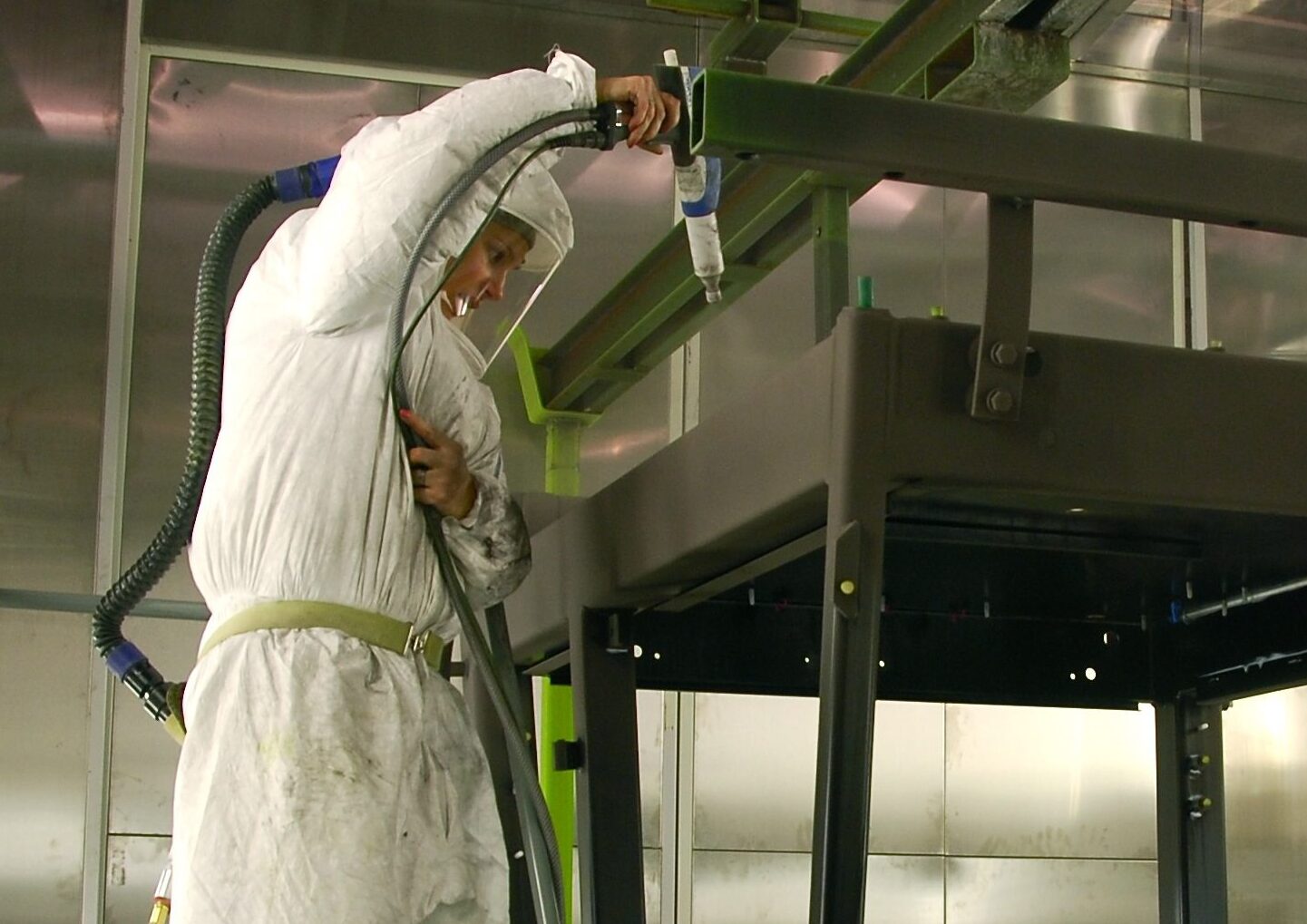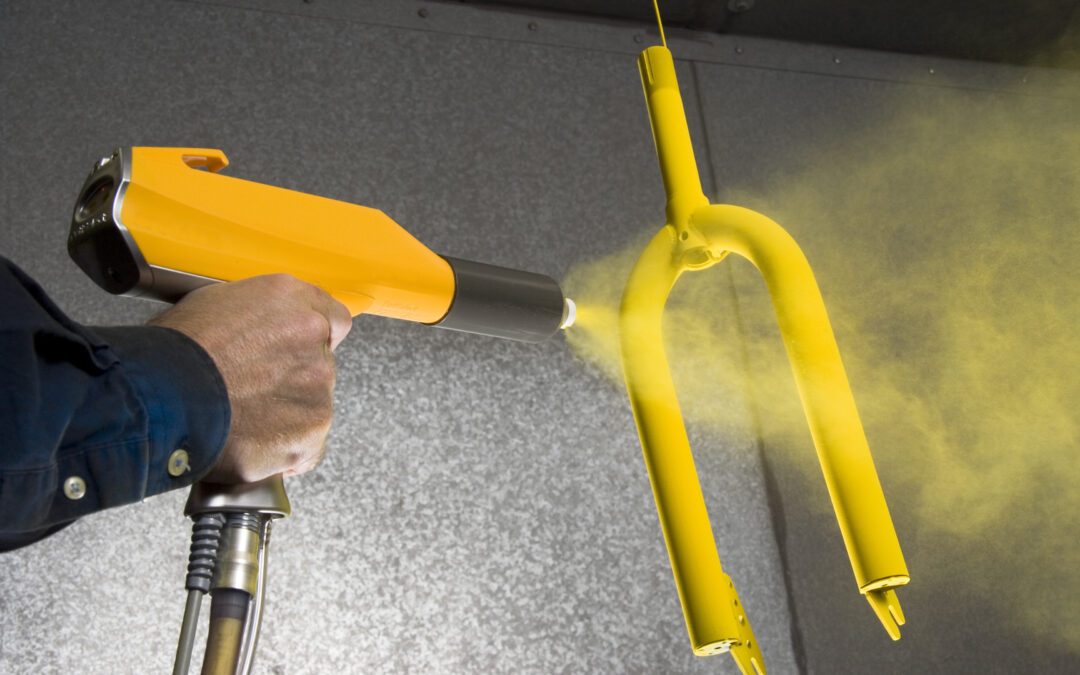Table of Contents
Switching from a traditional TGIC polyester powder coating to a TGIC-free alternative may seem simple, but caution should be exercised to ensure a smooth transition. You should be aware of differences in application performance, cure response, and coating performance before making the change.
Polyester powder coatings fall into two broad categories based on what curing agent is used as a crosslinker. These powders are commonly called “TGIC” and “TGIC-free” polyesters. TGIC refers to triglycidyl isocyanurate, a curing agent that has been in use since the 1970s. TGIC-free polyester powders debuted in the late 1980s and nearly always use an alternate curing agent, β-hydroxyl-alkyl amide (HAA), which is sometimes referred to as “Primid” (its original trade name).
Powder coating manufacturers, especially those that operate in the European Union (EU), have long since shifted polyester powder formulations from TGIC to TGIC-free due to toxicity issues with the handling of TGIC and products containing it. The EU and Australian regulatory agencies require strict labeling for powder coatings based on TGIC. However, American regulators do not require specific labeling for TGIC powder coatings. Nevertheless, it is always wise to confer with your powder supplier regarding how to handle TGIC-based and any other powder you may be using.
Formulation Differences
Both types of polyester powders use strikingly similar polymers. The resins are comprised mainly of terephthalic and isophthalic acids, with neo-pentyl glycol and low levels of other specialty monomers used to finetune melt viscosity, flexibility, and coating physical properties. Both polyester types have reactive carboxyl groups available to crosslink either curing agent.
TGIC is a compact molecule comprising a heteroxcyclic ring with three pendant glycidyl (epoxide) groups. These glycidyl groups react with the carboxyl groups on the polyester resin. HAA is another rather compact molecule that contains four reactive hydroxyl groups that crosslink with the carboxyl functionality of a polyester resin. Water is a reaction byproduct and evolves from the coating film during cure, whereas TGIC polyester powders emit no volatiles of cure.
| Property | TGIC | HAA |
| Functionality | Glycidyl (epoxide) | Hydroxyl |
| Number of functional groups | 3 | 4 |
| Equivalent weight | ~110 g/equivalent | 80-90 g/equivalent |
| Cure mechanism | Additive | Condensation |
| Cure volatile | None | Water |
| Melt point | 90-125°C | 120-124°C |
| Typical polyester/crosslinker ratio | 93/7 | 95/5 |
Application Properties
TGIC-free polyester powder coatings have been observed to exhibit measurably better application performance. These polyester-HAA powders accept an electrostatic charge more readily than their TGIC counterparts and therefore exhibit higher transfer efficiency and film build. Consequently, less overspray is generated with TGIC-free polyester powders, often providing better overall economics. In addition, most HAA polyester powders penetrate cavities and tight corners better than TGIC powders.
TGIC polyester powders have no volatiles of cure, which allows them to be applied at a wide range of film thicknesses. The low coating threshold is around 1.5 mils, and films of up to 10 mils are possible. TGIC-free powders emit water during cure, which can create pinhole defects in thick films. Consequently, the high film thickness threshold is around 4.0 to 5.0 mils for these products.
Curing Properties
TGIC polyester powder coatings have the advantage in low-temperature-cure capability. TGIC powder coatings can be formulated to cure at temperatures as low as 275°F. TGIC-free polyesters based on HAA have a low-temperature-curing threshold of around 335°F and in practice are cured about 20°F higher.
TGIC-based powders possess outstanding overbake color stability. Very little color drift is observed over a large cure temperature (and time) range. Alternately, TGIC-free powders tend to yellow with overbake, especially in white and lighter colors.

Film Performance
Physical Properties
Physical film properties such as impact resistance, flexibility, hardness, and abrasion resistance are generally comparable between TGIC and HAA polyester powder coatings. Formulation approaches can influence these properties, but neither polyester chemistry is inherently better than the other for basic mechanical film performance.
Outdoor Durability
The durability of a coating is predicated on several formulation variables. UV resistance of the primary polymer (polyester resin, in this case) significantly influences durability. Hence, the choice of specific polyester resin dictates the weathering resistance of the coating irrespective of whether it is cured with TGIC or HAA. The use of TGIC or HAA is weathering neutral, as both materials inherently provide good UV resistance.
Both standard durable and “superdurable” versions of TGIC and HAA polyester powders are available to the coating user. Standard durable polyesters withstand about 18 months of South Florida exposure before exhibiting signs of degradation, while “superdurable” polyesters can endure up to 5 years of that exposure before they appear to degrade.
Other formulation variables can affect outdoor durability. Non-durable pigments and additives can reduce weathering resistance, whereas UV absorbers and light stabilizers can enhance UV durability, especially in clear coats. These variables are independent of the crosslinker used in the formula (e.g., HAA vs. TGIC).
| Property | TGIC Polyester | TGIC-Free (HAA) Polyester |
| Application (electrostatics) | Good | Very good |
| Film thickness range | 1.5 – 10 mils | 1.5 – 5.0 mils |
| Low-temperature cure | 275°F | 335°F |
| Overbake stability | Excellent | Fair |
| Flexibility/impact resistance | Excellent | Excellent |
| Hardness/abrasion resistance | Good | Good |
| Chemical resistance | Very good | Good |
| Corrosion resistance | Very good | Good |
| Outdoor durability | Very good | Very good |
Chemical Resistance
TGIC polyesters typically have slightly better chemical resistance than their HAA polyester counterparts. The HAA curing mechanism emits water during the reaction, which makes the resultant coating somewhat less water-resistant than TGIC-cured polyesters. Consequently, the alkali and acid resistance of HAA polyesters is slightly less than TGIC polyesters.
Corrosion Resistance
Because of the potential for residual H2O from the cure mechanism, HAA polyesters are inherently less corrosion-resistant than TGIC polyesters. Formulation conventions affect the ultimate corrosion resistance, but a direct comparison demonstrates an advantage to the TGIC coating variants.
Cost/Performance Balance
Both powder coating types are relatively economical and possess a high level of performance. Outdoor durability is very good to excellent (1 to 5 yrs. Florida). Film performance is a very good balance of flexibility, hardness, and abrasion resistance. TGIC polyesters are more forgiving to process variables in powder manufacture and curing. On the other hand, HAA powders demonstrate an advantage in electrostatic behavior and transfer efficiency. Neither product is cost-prohibitive, and both provide good overall value to the coating user.
One Final Note
Handling issues, specifically toxicity, make HAA polyester powders an attractive choice. In most markets outside of Europe and Australia, however, TGIC polyester powders can be easily handled with the proper personal protective equipment and containment engineering. Please consult your coating supplier for specific details on handling any powder coating material.
For more information, reach out to the author at kbiller@chemquest.com.
Read in Products Finishing.

